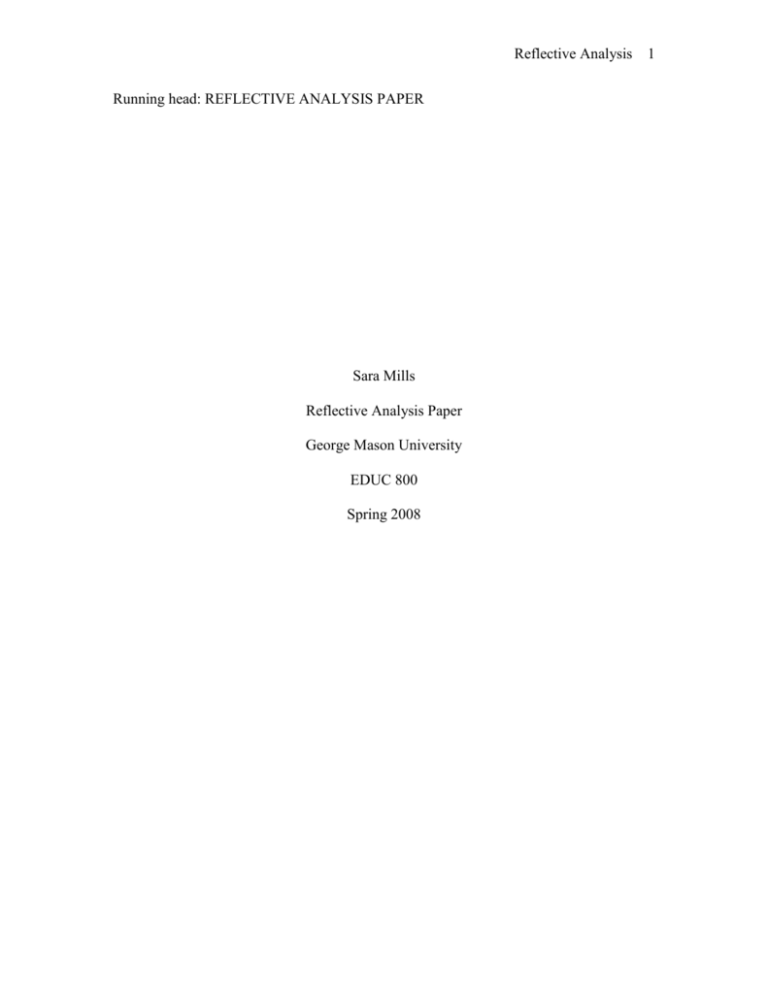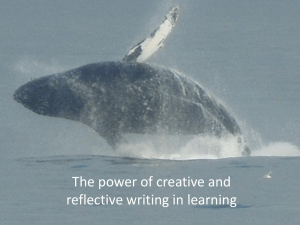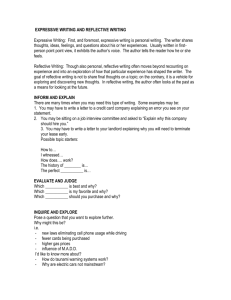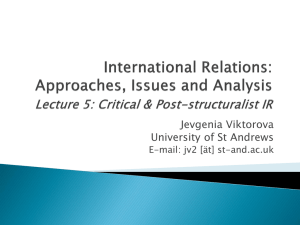REFLECTIVE ANALYSIS PAPER - Gmu
advertisement

Reflective Analysis Running head: REFLECTIVE ANALYSIS PAPER Sara Mills Reflective Analysis Paper George Mason University EDUC 800 Spring 2008 1 Reflective Analysis 2 This semester, taking Ways of Knowing has been like learning to drive a convertible. For many years, I was content to drive my car. The view through my windshield was wide enough to keep me safely on the road. I could see the other cars sharing the road with me and all the road signs. My mirrors provided me with a small, alternate view that helped me orient myself, making me aware of who was coming down the road behind me. I knew I had some blind spots, but a quick peek over my shoulder was adequate to make sure I could change lanes or turn without bumping into anyone. Then my husband and I bought a convertible. How glorious to ride down the road with the warm sun on my face, the wind blowing in my hair, the birds chirping happily as I drove by! The first time I drove the convertible was surely glorious, but it was also disconcerting. Now, I could not simply focus on the rectangle of my windshield. The world surrounded me, filling my senses with sights, sounds, and feeling. It was difficult at first to block out all the extra stimuli to focus on the road and driving. When I was stopped at a red light, people crossing the street would say hello. I could literally hear birds chirping while I drove, and noticed every sound the other cars on the street made as we passed each other. It was almost too much. I had to learn how to focus on the road ahead while absorbing all the other information around me. Now I am used to driving the convertible. When the top is up and all I can do is stare out the windshield, I feel cheated. It is exciting to drive with the top down, connected to the world around me. Now I know what I am missing when I have only my limited view. The limited view is fine, it gets me by, but there is so much more out there. I drive with the top down every chance I get. Reflective Analysis 3 My way of knowing has similarly changed throughout this semester. Where I used to have one lens to look through, I now have an awareness that there are many more lenses I could choose. I always knew other people had different points of view, but I only glanced at them briefly – like using my mirrors or checking my blind spots – without looking deeply. Now that I know I will learn different information by choosing an alternative lens to look through. I find that I ask more and different questions than I asked before. In the Beginning At the beginning of the semester, my way of knowing was solidly positivist. When I looked at my work life, I even saw myself in the logical positivist camp. I am the one who likes to ask a lot of detailed question about a situation to make sure I really understand it before acting. As a special education teacher, I look for evidence that instructional strategies are effective before trying them with my students. Research-based best practices are valuable to me. For my students with learning disabilities, the more systematic the instruction, the quicker they learn. For instance, I teach decoding skills using the highly controlled and sequenced Wilson Reading System. To teach writing, I rely on graphic organizers and step-by-step instruction. Beyond instructional strategies, logical positivism is the guiding force in evaluating and qualifying students to receive special education services. Not only do we try to analyze student potential and achievement on specific aspects of learning, but we also used checklists of characteristics to determine if the student is “disabled.” It is logical positivism, through and through, and I have been comfortable with that. Reflective Analysis 4 My comfort with the logical positivist way of knowing is in-line with my education and experiences. I come from a Eurocentric culture in which positivism has infused thinking for hundreds of years. My electrical engineer father and my chemistrymajor mother were explicitly trained to think as positivist, and that thinking was passed on to me. When my father buys a car, for example, he does extensive research, looking at consumer ratings and safety ratings. Before he even test drives a car, he knows which one he wants to buy. My mother has equally strong positivist thinking. For instance, when I graduated from college and got my first job, my mother tried to help me start an organized system of finances. Her explanations for why to do things a certain way all stemmed from what research shows about how to grow your money. In one example, she told me to contribute the full amount possible to my retirement fund in my first, 22,000 dollar-a-year job. She cited findings that contributing small amounts of money to retirement accounts in your 20s nets more retirement funds at age 65 than starting to save large amounts in your 40s. In addition to this seemingly genetic predisposition to positivism, all of my education has followed the positivist tradition. In my earliest memories of school, I remember learning phonics. Every discipline, even learning how to shoot baskets in physical education class, broke skills and content down to their smallest parts for analysis. (To shoot a basket, you must aim for one of the top corners of the square outlined on the backboard above the net.) My first introduction to the field of learning disabilities focused on the emerging field of brain research and understanding how a “normal” brain functions. Even in my teacher education classes years later, instruction Reflective Analysis 5 was presented as a positivist endeavor. Behavior management was about looking at methods of reinforcement that had their theoretical basis in the work of Skinner. I got my Master of Teaching degree just as the Virginia Standards of Learning (SOLs) were coming into schools. I was trained to start with the SOLs when planning instruction, and oriented around the idea of high-stakes testing. My entire teaching career has been spent “looking at the data.” And Now My ways of knowing, and the type of knowledge I value, has evolved during the course of this semester. I still value research-based practices. It matters to me whether a strategy I use with my students has evidence to back up its effectiveness. For example, Reading Recovery is used in the schools in which I work. Given the amount of instructional time needed to implement the program, and the great needs of the students it serves, it is important to have some “proof” that it works. Reading Recovery has the research to back up its claims of effectiveness. If I was asked to use Reading First with my students, I would be hesitant because of the lack of evidence supporting its effectiveness. That said, I have always felt that there is more to teaching than just teaching content. Our students are people with needs that go beyond being able to read, write and do math. They also need to grow up to be people with character, to feel part of their community, and to be positive members of society after they leave the boundaries of school. The students I serve as a special education teacher often need skills even more basic, like how to communicate, how to make friends, and even how to feed themselves. Reflective Analysis 6 While these are skills that logical positivists may attempt to teach just as mathematics is taught, I believe that these are skills most effectively taught in a more holistic way. Reading Bruner’s (1996) ideas about knowledge building through social interaction was a turning point for me. His arguments about the social nature of learning, and about how knowledge cannot be separated from the individual, made perfect sense to me. Bruner put into words things that I had sensed for a long time. Furthermore, his narrative approach to teaching and learning was powerful for me. We learn through story in all other setting in our life. Why shouldn’t we approach knowledge in the same way in schools? The use of narrative inquiry as a method for building knowledge was eye-opening for me (Lyons & LaBoskey, 2002). It provided a way to talk about other aspects of teaching that are just as critical as teaching subject matter. We often talk about the “art of teaching,” or say that some teachers “get it.” Narrative allows us to look more closely at that art, because it allows for a more global view without limiting what the answers to our questions can be. Narrative inquiry is also powerful because of the role it allows teachers to play in developing knowledge of effective teaching practices. In my opinion, it takes actually teaching in a classroom to really understand all of the variables that come into play on any given day for any given lesson. Being able to manage all of those variables to achieve student learning is what good teaching is all about. Teachers have that knowledge. Action research and narrative inquiry as ways of knowing are exciting because they recognize that rich teacher-knowledge as useful and valuable for others in the field of education. Reflective Analysis 7 Now that I know about alternative ways of knowing that address facets of teaching and learning that are not addressed through more traditional, positivist methods, I feel empowered. Instead of writing off the more holistic aspects of teaching as “art” that can only be appreciated, but not replicated, I now have a lens for looking more closely at these critical issues. Returning to the convertible analogy, I always knew there was a world outside of my car, but I had no way of accessing it with the top up. Once you take the top down, you can look at it all and describe things you could not describe before. You can see how factors not viewed through the windshield are affecting your driving experience. It is powerful. I would describe my current way of knowing as somewhere between positivism and post-positivism. As a researcher, my questions now are multi-faceted. For example, in the current research study I am working on as a graduate research assistant, we are looking at the effectiveness of a particular writing strategy with middle-school students with emotional disabilities. Next year we will be doing a single-subject research design so that there is more validity to our findings. Beyond knowing the increase in the number of essay parts students wrote, which is one of the data sources we are looking at, I also want to know how students view themselves as writers, and how their views of themselves have changed through participation in the writing intervention. There is a bigger picture that I feel it is important to capture. As I continue through my doctoral study, I think it is important for me to cultivate my skills in multiple types of research. Because I have more background in positivist approaches, I will probably have to attend more to developing qualitative research skills. I will be teaching an introductory special education course this summer. That will be a Reflective Analysis 8 great opportunity for me to try out narrative inquiry strategies to analyze my own teaching skills and growth. Finally, if my thinking continues to lie between positivism and post-positivism, I may want to consider doing a mixed-methods study for my dissertation. Ways of Knowing has been enlightening, challenging, exciting and frustrating. Changing the way one views the world is no easy task. Just like the experience of driving a convertible, however, it is hard to imagine going back to the days of moving through the world looking in only one way. I have already seen evidence in my personal life that taking the blinders off has changed my interactions with those around me. I see things I never would have thought to look for before. It continues to be challenging to integrate all of this uncovered information. I am hopeful that, like driving, the more I practice, the more natural it will become to see the world through these new perspectives. Reflective Analysis 9 References Bruner, J. (1996). The culture of education. Cambridge, MA: Harvard University Press. Lyons, N. & LaBoskey, V.K. (Eds.) (2002). Narrative inquiry in practice: Advancing the knowledge of teaching. New York: Teachers College Press.









